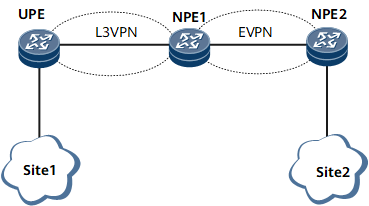Configuring Interworking Between a Common L3VPN and an EVPN L3VPN
When an L3VPN is being reconstructed into an EVPN L3VPN, co-existence of the EVPN L3VPN and L3VPN occurs. To prevent network reconstruction from compromising communication, configure interworking between L3VPN and EVPN L3VPN so that the EVPN L3VPN and L3VPN can communicate with each other.
Context
On the network shown in Figure 1, an L3VPN is already deployed. If a user wants to deploy an EVPN L3VPN over the network, co-existence of the EVPN L3VPN and L3VPN occurs during reconstruction. To ensure communication between the two VPNs, the user must configure interworking between L3VPN and EVPN L3VPN on NPE1.
Pre-configuration Tasks
Before configuring interworking between L3VPN and EVPN L3VPN, complete the following tasks:
Configure basic MPLS functions on the UPE, NPE1, and NPE2.
Configure an IGP on the UPE, NPE1, and NPE2 to implement route reachability.
Configure EVPN instances in BD mode on NPE1 and NPE2. For configuration details, see Establishing a BGP EVPN Peer Relationships.
Configure an L3VPN between NPE1 and the UPE. For configuration details, see Configuring a Basic BGP/MPLS IP VPN or Configuring a Basic BGP/MPLS IPv6 VPN.
Procedure
- Configure NPE1 and NPE2 to generate and advertise IP prefix routes.
For IPv4 services, perform the following configurations.
- Run system-view
The system view is displayed.
Run ip vpn-instance vpn-instance-name
A VPN instance is created, and the VPN instance view is displayed.
Run ipv4-family
The IPv4 address family is enabled for the VPN instance, and the VPN instance IPv4 address family view is displayed.
- Run route-distinguisher route-distinguisher
An RD is set for the VPN instance IPv4 address family.
Run vpn-target vpn-target &<1-8> [ both | export-extcommunity | import-extcommunity ] evpn
VPN targets are configured for the VPN instance IPv4 address family to mutually import routes with the local EVPN instance.
-
EVPN is enabled to generate and advertise IP prefix routes and IRB routes.
(Optional) Run tnl-policy policy-name evpn
EVPN routes that can be imported into the VPN instance IPv4 address family are associated with a tunnel policy.
Run quit
Exit from the VPN instance IPv4 address family view.
Run quit
Exit from the VPN instance view.
Run commit
The configuration is committed.
For IPv6 services, perform the following configurations.
- Run system-view
The system view is displayed.
Run ip vpn-instance vpn-instance-name
A VPN instance is created, and the VPN instance view is displayed.
Run ipv6-family
The IPv6 address family is enabled for the VPN instance, and the VPN instance IPv6 address family view is displayed.
- Run route-distinguisher route-distinguisher
An RD is set for the VPN instance IPv6 address family.
Run vpn-target vpn-target &<1-8> [ both | export-extcommunity | import-extcommunity ] evpn
VPN targets are configured for the VPN instance IPv6 address family to mutually import routes with the local EVPN instance.
-
EVPN is enabled to generate and advertise IP prefix routes and IRB routes.
(Optional) Run tnl-policy policy-name evpn
EVPN routes that can be imported into the VPN instance IPv6 address family are associated with a tunnel policy.
Run quit
Exit from the VPN instance IPv6 address family view.
Run quit
Exit from the VPN instance view.
Run commit
The configuration is committed.
- Run system-view
- Configure NPE1 to advertise routes regenerated by the EVPN address family to the BGP VPNv4/VPNv6 peer (UPE).
- Configure NPE1 to advertise routes regenerated by the VPNv4/VPNv6 address family to the BGP EVPN peer (NPE2).
Checking the Configurations
- Run the display bgp evpn all routing-table command on NPE2 to check information about EVPN routes received from the UPE.
- Run the display ip routing-table vpn-instance vpn-instance-name or display ipv6 routing-table vpn-instance vpn-instance-name command on NPE2 or the UPE to check information about VPN routes received from each other.
